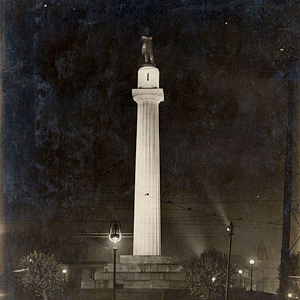Federal judge allows removal of Confederate monuments in New Orleans

A 1917 photo of the statue in Lee Circle at night. The statue of Robert E. Lee was raised, and Tivoli Circle renamed Lee Circle, in 1884. Image from Wikimedia Commons.
A federal judge has cleared the way for New Orleans to remove four Confederate monuments.
In a decision (PDF) on Tuesday, U.S. District Judge Carl Barbier denied injunctive relief to groups opposing the removal, report the Associated Press, the New Orleans Times-Picayune and the New Orleans Advocate.
Barbier said the plaintiffs “wisely chose” not to pursue a free-speech claim and failed to show their other arguments had a likelihood of success. Barber also said the plaintiffs had failed to establish a likelihood of irreparable injury if the statues are removed, because the monuments can be relocated without being damaged.
“The court is well aware of the emotions and passions that are involved in this case; however, this is a court, not a political body like the City Council,” Barbier wrote. “The court does not judge the wisdom, or lack thereof, of the actions taken by mayor or the City Council.”
Among the monuments slated for removal and storage are statues of Confederate Gens. Robert E. Lee and P.G.T. Beauregard and of the president of the Confederacy, Jefferson Davis.
The company initially selected to remove the monuments has now declined the job because of death threats, its owner said. After that announcement, the owner’s Lamborghini was destroyed in a suspicious fire.
The plaintiffs included several historic preservation groups. They had alleged violations of federal laws designed to protect historic sites; federal constitutional violations; and violation of a Louisiana constitutional provision recognizing the right of the people to preserve, foster and promote their linguistic and cultural origins.
Barbier said one of the plaintiffs’ equal protection claims focused on the city’s failure to target other Confederate monuments for take-down. “Plaintiffs essentially argue that all similarly situated monuments were not treated alike; however, the equal protection clause ensures the equal protection of persons, not monuments,” Barbier said.
Barbier also said the plaintiffs “wisely chose not to pursue of freedom-of-speech claim” because “the removal of monuments is a form of government speech and is exempt from First Amendment scrutiny.”
He also found no due-process violation because the plaintiffs did not have a property interest in the monuments and the city provided the plaintiffs an opportunity to be heard.
The plaintiffs’ claim under the Louisiana Constitution would also fail because the plaintiffs can’t compel the city to promote their culture, Barbier said.



